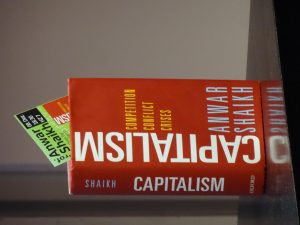Finance, Class, and the Birth of Neoclassical Economics: The Marginalist Revolution Revisited
✑ YAIR KALDOR` ╱ ± 2 minutes

A sea-change in economic thought in the 1870s, often labeled as “the marginalist revolution”, gave rise to what later became “neoclassical economics”. It has its roots in the rise of finance and the escalating class struggles across Europe.

Economic categories, of course, are not simply theoretical.
A sea-change in economic thought in the 1870s, often labeled as “the marginalist revolution”, gave rise to what later became “neoclassical economics”. It has its roots in the rise of finance and the escalating class struggles across Europe.
From: Economic Sociology and Political Economy, July, 2019. ╱ About the author
Yair Kaldor is a PhD candidate in the sociology department at the University of Wisconsin-Madison, and a member of Koah LaOvdim (“Power to the Workers”), an Israeli labor union. His fields of interest include class analysis, cultural and economic sociology, and the sociology of knowledge. His current research investigates the impact of financialization on income inequality, focusing on the use of corporate debt as a strategic tool in the context of class struggles.
In economic textbooks, the concept of “value” is regarded as nothing more
than the prevailing market price. This definition might seem self-evident,
but it stands in sharp contrast to the classical theories of Adam Smith and
David Ricardo, who used the notion of “value” to probe beneath the surface
of the market and discover objective factors that regulate economic
exchanges. It was only in the late nineteenth century, when the idea of “marginal utility” was first introduced into the field, that “value” came to be viewed as a
subjective measure that is reflected in prices. This transformation also
meant a change in the category of “market”, which came to be understood as
an abstract “resource allocation” mechanism, as opposed to a physical
marketplace or a specific geographic area in classical economics. This
sea-change in economic thought, often labeled as “the marginalist
revolution”, gave rise to what later became “neoclassical economics”, a
term coined at the turn of the century by Thorstein Veblen.
Besides its importance for the history of economic thought, the marginalist revolution also includes an interesting puzzle in the form of a “multiple discovery”. Its beginning is usually dated to the early 1870s, with the close publications of three economists working in remote locations – William Stanley Jevons (England), Carl Menger (Austria), and Leon Walras (France). Although they knew nothing of each other’s work, all three argued that the utility (satisfaction, benefit) someone derives from any good diminishes as its quantity increases. The utility derived from the last unit of the good, later labeled “marginal utility”, determines its price, which is a measure of its value. This was a clear break from classical economists, who argued that value is determined by the amount of labor used in production, or the total cost of production (including labor, land, and capital). Jevons, Menger and Walras used marginal utility to turn the classical theory of value on its head. Instead of labor, land and capital determining value, they insisted that it is the value of a good – now equated with its price – that determines the value of labor, land and capital.
Here also lies a second puzzle: despite their criticism of classical political economy and their different analytical framework, Jevons, Menger, and Walras reached the very same practical conclusions. Like the classical economists who preceded them, Jevons, Menger, and Walras insisted that the principle of marginal utility proves that it is impossible for workers to increase their wages through unionization and strikes, and that free trade is the best way to ensure economic prosperity for all.
In a recently published Socio-Economic Review article "The cultural foundations of economic categories: finance and class in the marginalist revolution", I revisit to the marginalist revolution in search of answers to these questions. For this purpose, the article incorporates a cultural emphasis on meaning-making processes within a macro-level analysis of the historical conditions in which these processes take place. The empirical section traces the roots of the marginalist revolution to the rise of finance as a dominant economic sector, and the escalating class struggles across Europe during the period. This analysis not only shows the social foundation from which these economic ideas rose, but also explains the different outcomes of the marginal revolution in England, France, Austria, and Germany.
Economic categories, of course, are not simply theoretical tools constructed by economists. They are also part of the everyday concepts through which people perceive and make sense of social reality. It should not surprise us, therefore, that when this reality changes, the categories used to understand it are likely to change as well. More specifically, the article identifies three ways in which macro-level developments shape and transform the basic categories of economics: (a) by creating new problems that might require new tools of analysis; (b) by providing the necessary conditions that are presupposed in these categories (c) by making make certain economic sectors more visible and providing new models for economic theorizing.
However, the article also makes clear that the way such developments are viewed and understood “on-the-ground” depends on the specific social position of the people who seek to make sense of them. In this sense, economic categories reflect a specific social standpoint , a term used by critical feminist theorists to remind us that the way we represent social reality is always from a distinct location within this social reality.
The marginalist revolution and the birth of neoclassical economics is an important research topic in its own right. However, the contributions of the article go beyond the historiography of economic thought. A long-standing scholarship in political science and sociology has shown the power of economic ideas to shape public policies and promote institutional change. A more recent literature examines economic categories through cultural lenses to show how they contribute to a wide-range of social and economic processes. However, there is a lack of research on the historical development of such categories. The present article provides a theoretical framework to examine these questions, in which economic categories are at the same time an outcome as well as a contributing factor to processes of structural changes.
Read the entire paper of Yair Kaldor in Socio-Economic Review (2018) here: "The cultural foundations of economic categories: finance and class in the marginalist revolution"
Besides its importance for the history of economic thought, the marginalist revolution also includes an interesting puzzle in the form of a “multiple discovery”. Its beginning is usually dated to the early 1870s, with the close publications of three economists working in remote locations – William Stanley Jevons (England), Carl Menger (Austria), and Leon Walras (France). Although they knew nothing of each other’s work, all three argued that the utility (satisfaction, benefit) someone derives from any good diminishes as its quantity increases. The utility derived from the last unit of the good, later labeled “marginal utility”, determines its price, which is a measure of its value. This was a clear break from classical economists, who argued that value is determined by the amount of labor used in production, or the total cost of production (including labor, land, and capital). Jevons, Menger and Walras used marginal utility to turn the classical theory of value on its head. Instead of labor, land and capital determining value, they insisted that it is the value of a good – now equated with its price – that determines the value of labor, land and capital.
Here also lies a second puzzle: despite their criticism of classical political economy and their different analytical framework, Jevons, Menger, and Walras reached the very same practical conclusions. Like the classical economists who preceded them, Jevons, Menger, and Walras insisted that the principle of marginal utility proves that it is impossible for workers to increase their wages through unionization and strikes, and that free trade is the best way to ensure economic prosperity for all.
Instead of labor, land and capital determining value, they insisted that it is the value of a good – now equated with its price – that determines the value of labor, land and capital.How can we explain the “multiple discovery” of marginal utility? Why did economists in the late nineteenth century understood the category of “value” as something completely different from the meaning it had earlier in the century?
In a recently published Socio-Economic Review article "The cultural foundations of economic categories: finance and class in the marginalist revolution", I revisit to the marginalist revolution in search of answers to these questions. For this purpose, the article incorporates a cultural emphasis on meaning-making processes within a macro-level analysis of the historical conditions in which these processes take place. The empirical section traces the roots of the marginalist revolution to the rise of finance as a dominant economic sector, and the escalating class struggles across Europe during the period. This analysis not only shows the social foundation from which these economic ideas rose, but also explains the different outcomes of the marginal revolution in England, France, Austria, and Germany.
Economic categories, of course, are not simply theoretical tools constructed by economists. They are also part of the everyday concepts through which people perceive and make sense of social reality. It should not surprise us, therefore, that when this reality changes, the categories used to understand it are likely to change as well. More specifically, the article identifies three ways in which macro-level developments shape and transform the basic categories of economics: (a) by creating new problems that might require new tools of analysis; (b) by providing the necessary conditions that are presupposed in these categories (c) by making make certain economic sectors more visible and providing new models for economic theorizing.
However, the article also makes clear that the way such developments are viewed and understood “on-the-ground” depends on the specific social position of the people who seek to make sense of them. In this sense, economic categories reflect a specific social standpoint , a term used by critical feminist theorists to remind us that the way we represent social reality is always from a distinct location within this social reality.
The marginalist revolution and the birth of neoclassical economics is an important research topic in its own right. However, the contributions of the article go beyond the historiography of economic thought. A long-standing scholarship in political science and sociology has shown the power of economic ideas to shape public policies and promote institutional change. A more recent literature examines economic categories through cultural lenses to show how they contribute to a wide-range of social and economic processes. However, there is a lack of research on the historical development of such categories. The present article provides a theoretical framework to examine these questions, in which economic categories are at the same time an outcome as well as a contributing factor to processes of structural changes.
Read the entire paper of Yair Kaldor in Socio-Economic Review (2018) here: "The cultural foundations of economic categories: finance and class in the marginalist revolution"
| Top image: From left to right: Economists Jevons, Menger and Walras. From: Wikimedia. |
|---|






















Comments
Post a Comment
Your thoughts...